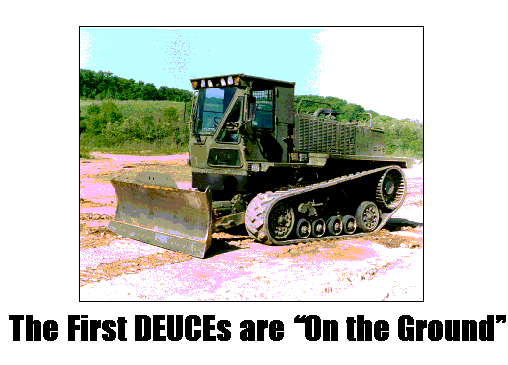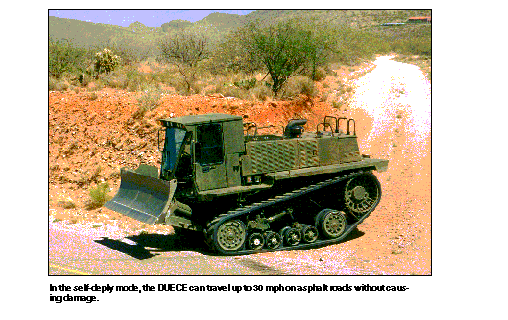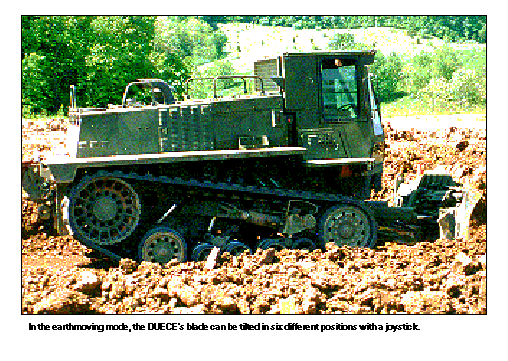


On 29 January 1999, the U.S. Army Engineer School received the first two production deployable universal combat earthmovers (DEUCEs). This highly anticipated earthmover, which will soon be in the Army construction equipment inventory, will provide light infantry and airborne combat engineers with an unprecedented self-deploy capability. The Engineer School's two DEUCEs will supplement the school's training mission by providing advanced technologies and will help define future mission doctrine.
In addition to receiving the equipment, Engineer School instructors, maintainers, and operators received instructor and key personnel training. These critical personnel will train future Army soldiers in the correct operation and maintenance of the tractors. They are at the top of a teaching pyramid that will rapidly multiply the number of properly trained engineer soldiers.

The DEUCE is the result of an ongoing partnership between the Tank-Automotive and Armaments Command (TACOM), in Warren, Michigan, and the contractor, Caterpillar Inc., Defense and Federal Products Department. A contract awarded to Caterpillar in 1995 is managed by TACOM's project manager for Tank-Automotive Weapon Systems (PM TAWS) and the product manager for Construction Equipment/Material Handling Equipment (PM CE/MHE). Representatives from both TACOM and Caterpillar attended the DEUCE hand-off at Fort Leonard Wood.
The DEUCE's engine, transmission, and suspension configuration combine to allow it to travel in the self-deploy mode at speeds up to 30 mph. It has an automatic 6-speed transmission and a fully suspended undercarriage. The rubber track is lighter and less damaging to road surfaces than a traditional steel-track design. This configuration allows for a safe and comfortable ride and eliminates the need for additional hauling assets between job sites.
The flip of a switch engages the earthmoving mode. The DEUCE operates with a standard power-shift transmission, a locked-out suspension for a rigid dozing platform, and a dozing capability comparable to the D5 dozer currently authorized to some 18th Airborne engineer units. The DEUCE is designed for driving on and off C-130, C-141, C-5, and C-17 aircraft and is undergoing certification testing for C-130 airdrops.
The DEUCE will be used primarily to prepare airstrips, roads, and protective positions. To increase its effectiveness, the operator may communicate from within the DEUCE with the single-channel, ground-to-air radio system (SINCGARS) and precise light-weight GPS (global positioning system) receivers (PLGR). The DEUCE uses a six-way hydraulic power-angle-tilt blade and a rear-mounted 22,000-pound hydraulic winch. The Caterpillar 3126 Hydraulic Electronic Unit Injector engine has dual power settings, which produce 185 hp in the earthmoving mode and 265 hp in the self-deploy mode. The DEUCE is equipped with an enclosed, climate-controlled cab that allows optimal performance from a less-fatigued operator. The engine, as well as 75 percent of about 3,000 serviceable DEUCE components, has proven its durability through Caterpillar's extensive commercial experience.

Initial testing indicated that the undercarriage design, although adequate for commercial applications, was not sufficient for rigorous military operations. After consulting with all appropriate commands, including U.S. Army Forces Command and the Engineer School, the PM CE/MHE initiated a nine-month testing and redesign period with the goal of improving the future readiness of the machines. The result is a much improved undercarriage design.
According to the assistant product manager for the DEUCE, the rubber track technology has been proven over the years on Caterpillar's Challenger series of agricultural tractor. The entire undercarriage, including the steel-reinforced solid rubber track, has undergone extensive testing across the country. Testing conditions included knee-deep mud and clay at Aberdeen Proving Grounds; frozen soil (sand, gravel, and clay) at Caterpillar's Minneapolis facility; desert rock and sand at Caterpillar's Arizona Proving Grounds; and a Midwest mix of clay, sand, gravel, and mud at Caterpillar's proving grounds in Peoria, Illinois. All of this data was incorporated in the final undercarriage design that soldiers will receive. Sharp volcanic rock in Hawaii and Fort Lewis, Washington, will undoubtedly increase the grouser wear rate, similar to the experiences of rubber-tired vehicles, but the transportability advantages of this type of track are necessary to meet the quick-strike capabilities of light and airborne engineers.
Before delivering these machines, unit personnel will receive three days of operator training and five days of maintenance training. The advanced design of the operator's compartment, along with the ergonomically designed operator controls, allow for these minimal operator-training requirements. For example, the automotive-type steering wheel, accelerator pedal, and brake pedal typically are not associated with tracked construction equipment.
The 10th Mountain Division (Light) at Fort Drum, New York, is scheduled to receive the first DEUCE in May 1999. The 82nd Airborne Division at Fort Bragg, North Carolina, will be outfitted with the DEUCE in June, followed by the 20th Engineer Brigade at Fort Bragg. Fielding the acquisition objective of 160 DEUCEs will continue through 2002.
The coming months will be busy as product managers from both TACOM and Caterpillar's Defense and Federal Products Department prepare for the initial fieldings. At that time, TACOM and all of the DEUCE team members will have achieved their goal of fielding a capable, reliable, and supportable piece of equipment to the soldiers of the 21st century.
Mr. Klein is the DEUCE project engineer and works on the Construction Equipment Team at TARDEC. He holds a bachelor's degree in mechanical engineering from Virginia Tech and a master's degree in mechanical engineering from Catholic University, Washington, D.C.